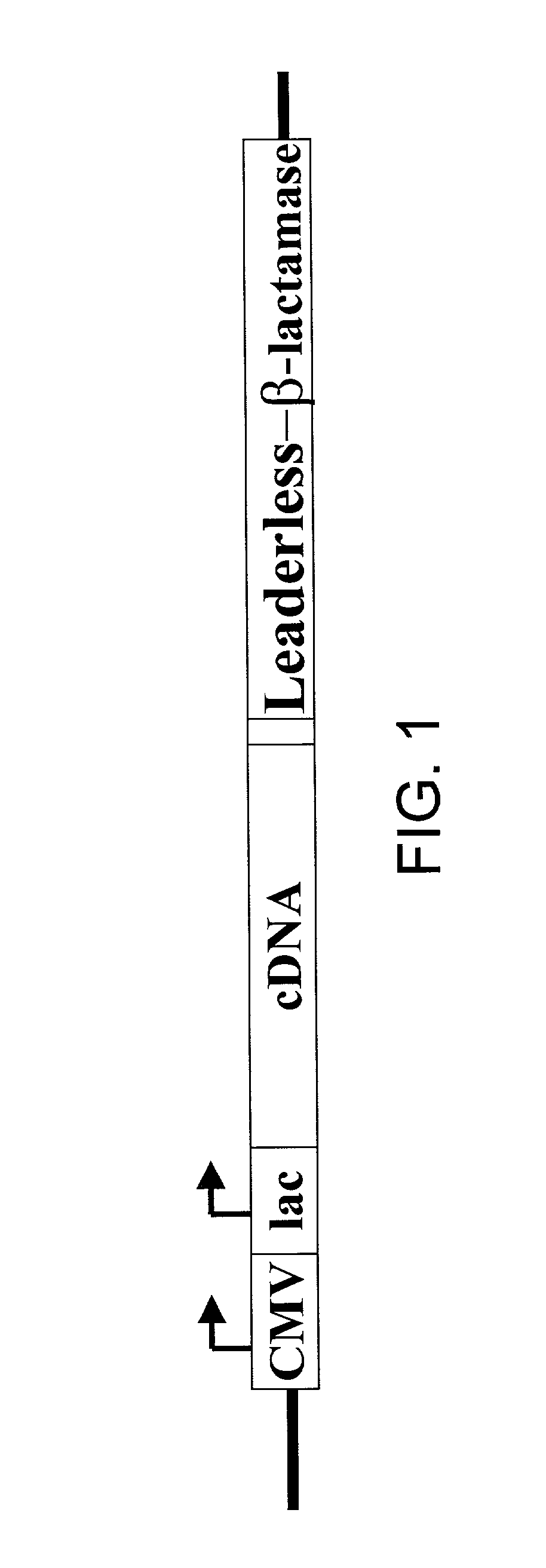Method for identification of cDNAs encoding signal peptides
a signal peptide and cdnas technology, applied in the field of protein identification and isolation, can solve the problems of inability to identify or isolate secreted or transmembrane proteins solely, inability to achieve even this relatively moderate level of secretion of certain signal sequences in mammals, and inability to select invertase sequences further inadequate, etc., to achieve fast and effective methods
- Summary
- Abstract
- Description
- Claims
- Application Information
AI Technical Summary
Benefits of technology
Problems solved by technology
Method used
Image
Examples
example 1
Vector Construction and Selection of cDNAs Encoding Secreted Fusion Proteins
[0069] A vector expressing .beta.-lactamase under a CMV promoter was generated using the vector pBK-CMV (STRATAGENE). The ATG at position 1183 was removed from pBK-CMV vector to prevent non-selected translation, and an EcoRI site was created in the 3' end of lac promoter. A PCR-generated .beta.-lactamase nucleic acid was engineered to have an EcoRI site at the 5' end and a KpnI site at the 3' end. This fragment was inserted between the EcoRI and KpnI sites of the modified pBK-CMV parent vector described above. The modified vector expressing a leaderless-.beta.-lactamase gene, in which the N-terminal 23 amino acids signal sequences were deleted was generated with an EcoRI site at the 5' end and a KpnI site at the 3' end. This engineered leaderless .beta.-lactamase fragment was inserted the between EcoRI and KpnI sites of the modified pBK-CMV vector. This vector was called pBK-CMV-leaderless-.beta.-lactamase. ...
example 2
Generation of a pBK-CMV-cDNA-.beta.-Lactamase Library.
[0081] Synthesized 5' biased cDNA was produced as described in U.S. Pat. No. 6,083,727. The generated cDNAs were inserted between EcoRI and NotI sites of the pBK-CD4-.beta.-lactamase vector. Following insertion, these cDNAs were selected as described in Example 1, and the cDNA sequences contained within the selected bacteria were analyzed. Approximately 1% of all transformed bacterial clones were selected. A signal peptide was confirmed in 50-60% of the clones analyzed. Of these, 40% were novel proteins. Validation of the secreted proteins via transfection into mammalian cells indicated that at least half of the selected proteins are secreted in mammalian cells.
PUM
| Property | Measurement | Unit |
|---|---|---|
| temperature | aaaaa | aaaaa |
| temperature | aaaaa | aaaaa |
| temperature | aaaaa | aaaaa |
Abstract
Description
Claims
Application Information
 Login to View More
Login to View More - R&D
- Intellectual Property
- Life Sciences
- Materials
- Tech Scout
- Unparalleled Data Quality
- Higher Quality Content
- 60% Fewer Hallucinations
Browse by: Latest US Patents, China's latest patents, Technical Efficacy Thesaurus, Application Domain, Technology Topic, Popular Technical Reports.
© 2025 PatSnap. All rights reserved.Legal|Privacy policy|Modern Slavery Act Transparency Statement|Sitemap|About US| Contact US: help@patsnap.com


